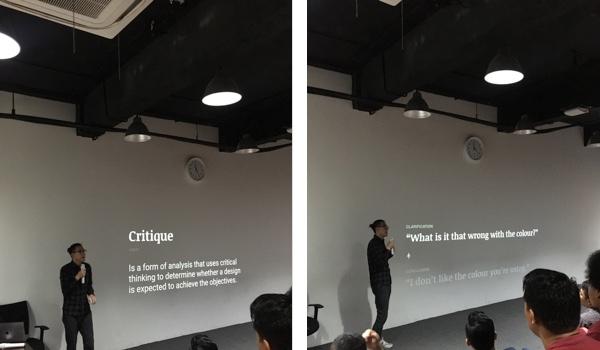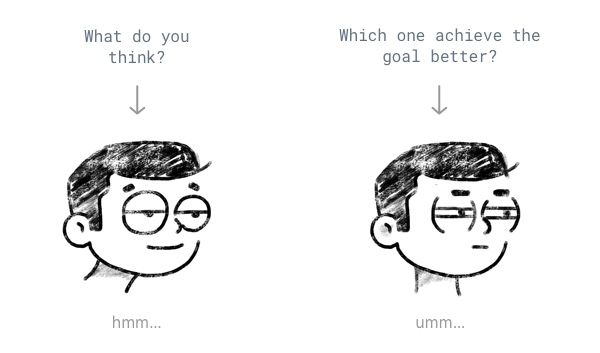Oct 15, 2018 | by Budi Tanrim
About design critique
How I see critique as a beneficial culture and my experiment with it.

Last week in Bukalapak Design All-hands, I had a chance to share my thought on how critique culture can be beneficial for the individual crafter, the quality of work they’d produce, and the team.
Let me be clear. I’m no expert at giving or asking critique. In fact, I used to give bad critiques without realizing it and this is something I’m still working on. However, I firmly believe that a healthy critique culture is beneficial.
Uh-hm… Why should I care about critique?
That’s a good and valid question. Let’s start there.
So you’ve worked hard on your craft, you explore the different possibility to solve the problem, and you’ve even tried to anticipate all the edge cases. Now what? For most people, they’ll take a step back and see what can they’ve done better.
But, here’s come the real question. How would you do that?
Critiques help you improve your work. And more.
In the design world, I find it is nearly impossible to improve a design without feedback from others. If you work at the highly collaborative environment, critique becomes the essential part to help you avoid mistakes, find your blind spot, and at the end of the day will improve your work.
In short, having a healthy critique culture in your team can help you:
- Identify the blind spots
- Identify missed opportunities
- Weigh the trade-off based on the design choices
- Review how effective the design to achieve the objectives
- Get you back on the right track
Okay. What is Critique?
Adam and Aaron, in their book Discussing Design, describe an excellent definition of what good critique is:
Critique is a form of analysis that uses critical thinking to determine whether a design is expected to achieve the objectives. Adam Connor and Aaron Irizarry
This definition really resonates to me, because I think good critique focuses on objectives of the design and remove the personal opinion from the equation. You see, design mostly has a goal its intent to achieve. Therefore, the discussion and critique should be tied back to the goal.
My note and experiment with critique
Critique is complicated! Throughout a year, I’ve been trying to get better at it. So I’ve been experimenting with a few things and I want to share my thoughts.
So far, these are a few aspects I’m looking at when asking for critique.
- The context
- The question
- The mindset
On the other hand, these are some points I’m still trying to get better when giving critique:
- Leading with questions
- Be complete and articulate why
- Avoid selfish critique
- Separate the person with the work
When asking for critique…
1. The context
With context vs without context
One day on the fresh eyes1 session. I presented a few explorations without context whatsoever to see how it goes. Later, I noticed people started to shape a very surface-level feedback, while others asked questions to gain the context a bit more.
My personal takeaway: Without context, people will focus on surface things. Maybe this is what you want, it’s not always bad though. But, generally speaking, without enough context, people spend their time understanding the context instead of focusing on analyzing the design and the goal. Without setting the stage, you might end up with an inefficient meeting.
2. The question
Generic question vs specific question
The question we’re asking could determine what kind of feedback we’ll get.
For instance, when showing design exploration, you can either ask a generic question like “What do you think?” or more specific question like “Which one achieve the goal better?” You should choose this carefully, if you just want to get people’s thought in general, maybe the generic question is okay. However, I often find myself getting a valuable feedback when I ask a specific question.
My personal takeaway: Unless you want to hear people’s opinion or gut-reaction, the last question you want to ask is “What do you think?” question. This question is often inviting subjectivity. More importantly, this question doesn’t help people to understand the scope of the discussion. To illustrate this:
 Left: Generic question will invite brutal subjective opinion. Right: Specific question frame the discussion and make people think ril' hard.
Left: Generic question will invite brutal subjective opinion. Right: Specific question frame the discussion and make people think ril' hard.
3. The mindset
Don’t fish for compliments
This one is less of an experiment, rather it’s a quick note. As human being, it’s our nature to look for validation. However, we shouldn’t hope or use critique session to fulfill that. Instead, focus on identifying what we missed, what mistakes we did, and what/how we can improve. Compliments will come naturally when you did a good job, don’t too worry about it.
When giving critique…
1. Lead with question
The common blocker for people to give good feedback is lack of context or knowledge. By asking questions, you’ll gain more context and then you can be more helpful.
I’m not saying that we have to ask questions all the time. If we know the context and can help analyze the design, there’s nothing wrong by just give the point right away.
2. Be complete and articulate the why
Not only we should understand the context and analyze whether the design achieves its objective. Whenever possible, once you give your opinion based on analyzing the design, try to articulate the why to make it a complete feedback.
3. Avoid selfish critique
Fundamentally, if we’re trying to critique a work, we should focus on the problem and analyze their works. Unless necessary, we should avoid offering a new solution on top of theirs — that is a straight selfish act.
My personal takeaway: If I have an idea, I better talk about it in the other place. Not to make people listen to my idea while they’re asking for feedback.
4. Separate the person with the work.
When giving a critique, focus on the work, not the person. It’s easier to find fault on the person than to look for the fault within the context of what that person is doing. I’d love to quote Steve Jobs during his interview with Bob Cringely,
“The most important thing I think you can do for somebody who’s really good and who’s really being counted on is to point out to them when they’re not — when their work isn’t good enough. And to do it very clearly and to articulate why…” Steve Jobs
Noticed Jobs caught himself commenting about the person “…when they’re not…“ and quickly corrected himself to “…when their work isn’t good enough.” Realizing it or not, I think Jobs aware of how important to separate the person with the work.
Should I ignore a bad critique?
Maybe.
Sometimes, what it seems as a bad critique could have a good point behind it. The bad critique may appear because the critiquer2 don’t yet have the right vocabulary or language to articulate it. Therefore, try to ask some clarification questions before you neglect that critique.
Scenario 1
A: “I don’t like that color,”
B: “What is it that wrong with the color?”
A: “I don’t know, I don’t like it,”
In this type of scenario, you probably can go ahead and ignore it because it’s preferential3. At least until further clarification from the critiquer. Okay, now let’s see the other scenario where the critiquer can better elaborate his thought.
Scenario 2
A: “I don’t like that color.”
B: “What is it that wrong with the color?”
A: “I think the red color is too alarming.”
B: “Why alarming is bad here?”
B: “Well, it distracts the users from what’s important.”
You see, in this scenario, we started from what it seems a subjective opinion into a valid consideration. The red color probably is too alarming in the context and distracts people.
Takeaway: Ask clarification question to decide whether you should ignore or dig deeper into the critique. Maybe you can get something out of it.
Closing chat to the reader
Critique is a hard topic to write due to the ambiguity and lots of factors to consider. Please notes this post written based on my experience. Therefore, please adjust this to your own context. I hope there are some useful takeaways!
Please reach me out if you have your thought or framework on building a good critique culture in the team.
note: I noticed a lot of you have been sharing the previous post and it actually means a lot to me. It actually drives me to write responsibly. Thank you, gangs!
Footnotes:
- Fresh eyes is a session where we spend 1 hour to exchange feedbacks and thoughts. Normally with a few people presenting their works. ↩
- Critiquer is the person who gives the critique. ↩
- It means the critiquer giving a feedback that’s purely comes from his opinion without considering the goal. ↩
Hi, this blog is no longer active. I move to substack. You can subscribe below or go to newsletter.buditanrim.co



